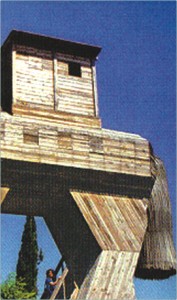| Spotlight
When virus is named Trojan horse

Lately my computer was showing some symptoms of 'illness' and following the advice of a software engineer I scanned all the drives with a powerful anti-virus. I was taken aback when I saw a dozen of viruses were detected and many of them were named 'Trojan horse'. It gave me a mixed feeling of good and evil, awe and admiration, destruction and creation. I thought whoever has created the wacky stuff possesses quite good sense of humour being a computer scientist, s/he also has good knowledge of classical literature. The Trojan horse is where science and art meets, where technology and mythology is integrated.
 We all know the story of Trojan War and the famous (or infamous) wooden horse used in it. Recall the background of the story - how Helen, the wife of Menelaus and queen of Sparta, eloped with Paris, the prince of Troy (although some would say Helen was abducted by Paris). The incident caused a bitter battle between the army of Agamemnon, the king of Mycenae and brother of Menelaus, on one side and that of Priam, the king of Troy, on the other. In that war the army of Agamemnon became victorious, not much because of the heroism of great warriors, but because of the trick of wooden horse. The wooden horse, which held selected Agamemnon army in its hollow belly, was dragged inside the city by the unsuspecting Priam folks, only for a disaster. At dead of night the hidden sword-wielders came out of the horse, opened the city gates thereby letting the fellow fighters in, and then all together launched a fierce attack on the sleeping people of Troy. They burned the houses and killed almost all the people. The total Troy was thus destroyed. We all know the story of Trojan War and the famous (or infamous) wooden horse used in it. Recall the background of the story - how Helen, the wife of Menelaus and queen of Sparta, eloped with Paris, the prince of Troy (although some would say Helen was abducted by Paris). The incident caused a bitter battle between the army of Agamemnon, the king of Mycenae and brother of Menelaus, on one side and that of Priam, the king of Troy, on the other. In that war the army of Agamemnon became victorious, not much because of the heroism of great warriors, but because of the trick of wooden horse. The wooden horse, which held selected Agamemnon army in its hollow belly, was dragged inside the city by the unsuspecting Priam folks, only for a disaster. At dead of night the hidden sword-wielders came out of the horse, opened the city gates thereby letting the fellow fighters in, and then all together launched a fierce attack on the sleeping people of Troy. They burned the houses and killed almost all the people. The total Troy was thus destroyed.
Now we can realise why the computer scientist chose the significant epithet of 'Trojan horse' for the virus which has immense power of destruction. The virus corrupts files and obliges the computer to malfunction. It is as dangerous as Trojan horse. It surreptitiously enters the machine and destroys it, in a fashion of midnight Trojan inferno. Indeed it requires brilliance to find out such a name. By the way, one thing should be clearly stated, I am not admiring the awfully technical know-how of the software specialist who created the virus, but the literary sense he has demonstrated in naming the virus. His job, creating a virus, is unethical, no doubt, but it must be admitted at the same time, the name is mythical so as to arouse a kind of insidious attraction to it. There is sometimes contradiction between ethics and aesthetics!
Now, don't mind as I use the phrase 'Trojan horse' loosely. By Trojan horse, as a layman, I mean any malicious programme that affects computer and its files. The experts may, however, outright reject my idea of identifying Trojan horse as virus.They would say, pointing at subtle characteristics: Trojan horse is not a virus! Then what is it? Trojan horse is Trojan horse, or briefly, Trojan is Trojan.
Computer science distinguishes Trojan from two other categories of 'malware' (malicious or wicked software) - virus and worm.
 Virus, worm and Trojan are all malicious programmes that can cause damage to computer, but there are differences among the three. Virus is said to be the malware that attaches itself to a programme or file so it can spread from one computer to another, leaving infections as it travels. It infects the computer when it is run. A worm is similar to a virus by its design, but unlike a virus, it has the capability to travel unaided and to replicate itself. In contrast, Trojan horse (or Trojan) is a destructive programme that masquerades as a benign application, that is, it installs malicious software while under the guise of doing something else. Virus, worm and Trojan are all malicious programmes that can cause damage to computer, but there are differences among the three. Virus is said to be the malware that attaches itself to a programme or file so it can spread from one computer to another, leaving infections as it travels. It infects the computer when it is run. A worm is similar to a virus by its design, but unlike a virus, it has the capability to travel unaided and to replicate itself. In contrast, Trojan horse (or Trojan) is a destructive programme that masquerades as a benign application, that is, it installs malicious software while under the guise of doing something else.
 A Trojan horse is full of as much trickery as the mythological Trojan horse it was named after. The Trojan horse, at first glance will appear to be useful software but will actually do damage once installed or run on your computer. Those on the receiving end of a Trojan horse are usually tricked into opening them because they appear to be receiving legitimate software or files from a legitimate source. When a Trojan is activated on the computer, it can cause serious damage by deleting files and destroying information in the system. Trojans are also known to create a backdoor on the computer that gives thief users access to your system, possibly allowing confidential or personal information to be compromised. A Trojan horse is full of as much trickery as the mythological Trojan horse it was named after. The Trojan horse, at first glance will appear to be useful software but will actually do damage once installed or run on your computer. Those on the receiving end of a Trojan horse are usually tricked into opening them because they appear to be receiving legitimate software or files from a legitimate source. When a Trojan is activated on the computer, it can cause serious damage by deleting files and destroying information in the system. Trojans are also known to create a backdoor on the computer that gives thief users access to your system, possibly allowing confidential or personal information to be compromised.
Trojan horse was instrumental in destroying a mythical city (we do not know whether the city of Troy really existed or not). After millennia it has appeared again with all its viciousness to threaten the world of computing. It has emerged from the shadow of myth to the virtual reality of science. Scan your computer regularly and remain out of danger. Don't let the chariot of Downloader-EV, Pest Trap, NetBus, Flooder, Tagasaurus, Vundo, Gromozon or any other Trojan horses to blast your system! But one necessary thing to remember, you cannot kill a Trojan like a virus. If a Trojan is detected, you have to immediately delete the whole file it has infected. That is the only way to get rid of it. No neglect. You cannot be as gullible as the people of Troy!
The writer is an Assistant Professor, English, Bangladesh University. He can be reached at: binoy_barman@yahoo.com
Copyright
(R) thedailystar.net 2008
|

